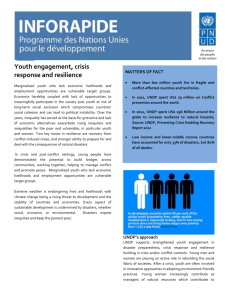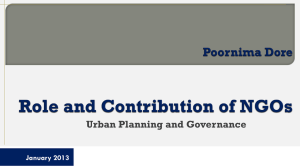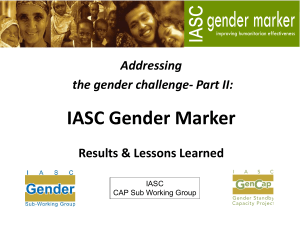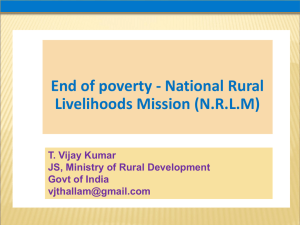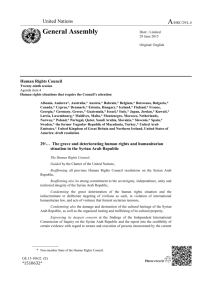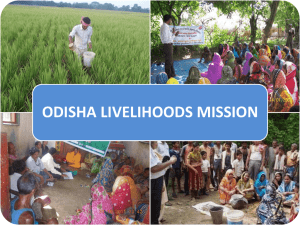UNDP Syria Proposal Japan fund March2013 Final
advertisement
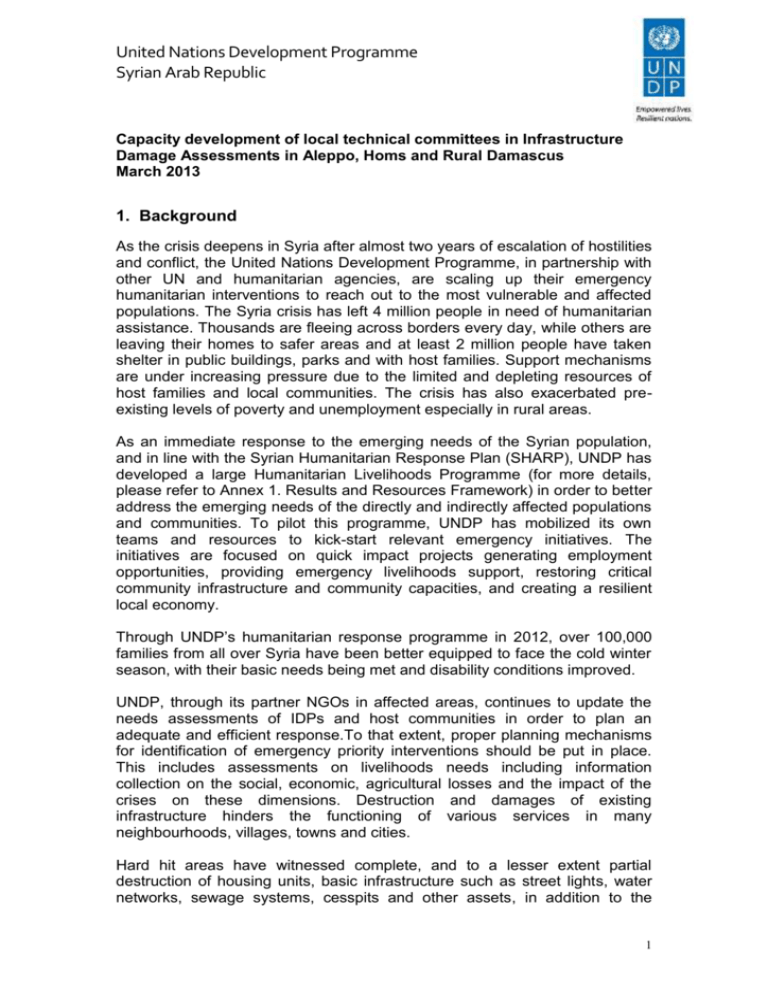
United Nations Development Programme Syrian Arab Republic Capacity development of local technical committees in Infrastructure Damage Assessments in Aleppo, Homs and Rural Damascus March 2013 1. Background As the crisis deepens in Syria after almost two years of escalation of hostilities and conflict, the United Nations Development Programme, in partnership with other UN and humanitarian agencies, are scaling up their emergency humanitarian interventions to reach out to the most vulnerable and affected populations. The Syria crisis has left 4 million people in need of humanitarian assistance. Thousands are fleeing across borders every day, while others are leaving their homes to safer areas and at least 2 million people have taken shelter in public buildings, parks and with host families. Support mechanisms are under increasing pressure due to the limited and depleting resources of host families and local communities. The crisis has also exacerbated preexisting levels of poverty and unemployment especially in rural areas. As an immediate response to the emerging needs of the Syrian population, and in line with the Syrian Humanitarian Response Plan (SHARP), UNDP has developed a large Humanitarian Livelihoods Programme (for more details, please refer to Annex 1. Results and Resources Framework) in order to better address the emerging needs of the directly and indirectly affected populations and communities. To pilot this programme, UNDP has mobilized its own teams and resources to kick-start relevant emergency initiatives. The initiatives are focused on quick impact projects generating employment opportunities, providing emergency livelihoods support, restoring critical community infrastructure and community capacities, and creating a resilient local economy. Through UNDP’s humanitarian response programme in 2012, over 100,000 families from all over Syria have been better equipped to face the cold winter season, with their basic needs being met and disability conditions improved. UNDP, through its partner NGOs in affected areas, continues to update the needs assessments of IDPs and host communities in order to plan an adequate and efficient response.To that extent, proper planning mechanisms for identification of emergency priority interventions should be put in place. This includes assessments on livelihoods needs including information collection on the social, economic, agricultural losses and the impact of the crises on these dimensions. Destruction and damages of existing infrastructure hinders the functioning of various services in many neighbourhoods, villages, towns and cities. Hard hit areas have witnessed complete, and to a lesser extent partial destruction of housing units, basic infrastructure such as street lights, water networks, sewage systems, cesspits and other assets, in addition to the 1 United Nations Development Programme Syrian Arab Republic severe damages of various service centres including education, social, health and other public and private facilities. This impedes the immediate return of the IDPs to their original locations, and prolongs their displacement. On the other hand, there is a large number of the population that had remained in their affected areas with disrupted utilities and difficult access to basic services. In light of the current situation, detailed damage assessments are not taking place, whether due to the difficulty of accessing the hard hit areas, but more importantly due to the lack of well-capacitated staff and community members to conduct such complex technical assessments. To this end, a well-coordinated systematic damage assessment is crucial to reveal the extent of destruction of various local service delivery and basic infrastructure facilities, in addition to public and private housing and business. The outcomes of such damage assessments will inform the response planning mechanism and the development of adequate interventions for quick repairs, full rehabilitation and/or reconstruction efforts. These assessments will be coordinated by a national recovery cell/unit relying on data collection at the governorate levels and linked to a management information unit. 2. Strategy 2.1 Overall objective As a major step towards reviving the life normalcy for the affected population, quick rehabilitation and repairs of damaged basic infrastructure and service delivery facilities (including medical, social, educational) becomes crucial to ensuring access by vulnerable and affected populations to adequate services and more importantly a safe return to their homes. However, this is only possible if damages are systematically assessed, response plans for early recovery interventions and reconstruction are put in place and immediate rehabilitation actions are operational. Thus, the need of a standardized damage assessment to be ultimately implemented in conflict-affected areas is essential. This would entail training of local technical committees to carry out the assessments, develop a database to unify and standardize data collection and analysis for prioritization and targeting mechanisms at later stages. This project will then develop the capacity of the local communities (CBOs, engineers, professional associations, relevant local technical directorates, etc.) to immediately respond to the emerging needs. Moreover, it will create an opportunity to employ local labour in the assessment stages, data collection, data entry and analysis and later on engage them in the repair and rehabilitation works which will ultimately provide an occasional source of income for the unemployed in the target local areas and governorates. 2 United Nations Development Programme Syrian Arab Republic The overall objective of the proposed project contributes to strengthening the resilience of the Syrian people to cope with the effects of the current unrest and enable those whose livelihoods were severely disrupted to recover and rebuild their lives. The project’s specific objectives are to ensure that proper damage assessment methodologies are developed and relevant technical people are trained and ready to engage in such local level assessments particularly in the hard hit areas. The safe return of IDPs to their homelands is contingent on the outcomes of such damage assessments and pertinent rehabilitation actions. Local committees and technical staff from Homs, Aleppo and Rural Damascus will be trained and capacitated to start the initiation of quick damage assessments in accessible neighbourhoods. 2.2 Project components Considering the current conflict in Syria and the levels of human suffering and physical destruction, UNDP considers the mapping of recovery and reconstruction needs as well as physical damages as a cornerstone for accurate interpretation of the gaps, proper targeting of any assistance and effective monitoring and evaluation of assistance. UNDP is prioritizing the requirement for a unified nation-wide coordination system supported by an effective database, that would be functional in all stages from humanitarian, to (early) recovery and reconstruction. In order to achieve the above-mentioned specific objectives, this project will serve the overall output on “Coordination systems for emergency livelihoods enhanced“ as stipulated in the larger UNDP humanitarian livelihoods programme, and will consist of the following major activities to be implemented over a nine (9) months period: Output: Coordination systems for emergency livelihoods enhanced This project will enhance and reinforce the livelihood and early recovery network as well as foster the various relevant working groups that are in place or to be activated. Coordination with all stakeholders will be a priority to ensure synergies, coherence, and avoidance of duplication and maximization of resources. A coordination that facilitates response planning, targeting, implementation and tracking will be developed in the form of an active database resorting to GIS and interactive mapping and reports. This mechanism can also serve as a monitoring tool for the UN to better assess the gaps, needs, response and the future plans for humanitarian, (early) recovery processes in the country. The project will mainly focus on: 1. Development of Damage assessment tools and system: 3 United Nations Development Programme Syrian Arab Republic - - - - - - Develop the damage assessment tool, based onacomprehensive questionnaire including all elements and parameters to be assessed Pre-test the assessment tools (locations might be subject to change depending on the security factor. The proposed assessment is at village/city level feeding later into a district then region level) Identify the local committees, technical expertise and relevant local stakeholders for liaison, identification, training and assessment purposes Develop the Information Management System and the related database for the infrastructure damage assessment. The database is to be expanded to include new areas in the future. 2. Capacity Development on the damage assessment tool: Technical representatives from local committees, trained on standardized infrastructure damage assessments, taking into consideration good governance elements and participatory approaches in devising the related methodology and tools. Identify representatives from Homs, Aleppo and Rural Damascus to be fully engaged in the training on Infrastructure Damage Assessment: the selected persons (professional men and women) will come from local associations, local engineers, youth volunteers, and other stakeholders with the relevant technical background. Develop the training packages and surveying methodology (also relying on best practices from UNDP Lebanon and Iraq re-construction programmes). Conduct capacity development programme based on three training packages: 1. Use of assessment tools, 2. Ensure participatory approaches and good governance elements in modality of implementation of the surveys, 3. Use of the database, data entry and analysis for prioritization and targeting mechanisms based on specific parameters and indicators. Conduct the Training of Trainers (TOT) to at least 15 trainees. The core trainers will be utilized to transfer the knowledge and develop the capacity of other engineers, members of CBOs and local associations that can be involved in the field surveying exercise. Also, to conduct trainings in new areas that might be included in the future. The project will target local committees and technical expertise and concerned stakeholders from various governorates with particular focus on Aleppo, Homs and Rural Damascus 3. Partnerships The ultimate objective of this project is to ensure that restoration and rehabilitation plans are adequately responding to the destruction 4 United Nations Development Programme Syrian Arab Republic ofinfrastructure and disruption of basic services, which will facilitate the quick return of the IDPs to their homelands. As such, affected communities and their relevant representatives and local stakeholders will be involved in the project implementation. On the other hand, local associations, syndicates of engineers and local actors will have an important role in directly accessing the affected populations, bridging the communication gap between the national level and the local level where difficulties of access and direct contact were observed. Full engagement of local level representatives will facilitate the actual data collection and conducting the damage assessment at later stages. Moreover, strategic and operational partnerships will be maintained with other UN agencies to fill in the gaps and compliment the data base fields and requirements. Finally, Japan will constitute an active partner in the overall process and will be consulted at various stages of the project implementation, particularly for the transfer of knowledge and best practices in managing large information management systems and databases to learn from the existing experience in crisis management and response. 4. Project Management The project will be implemented by UNDP through its technical teams and partner NGOs in close partnership with other concerned UN agencies. The selection of local stakeholders, committees and professionals to be trained on the use of the damage assessment tool and database is carefully carried out based on capacity, relevance and engagement. A dedicated team will work on the implementation of this project at central and local levels. In Damascus, a technical support team will provide technical guidance, communication, logistics and administrative and financial support, whereas field teams in target areas will be working on the identification of the beneficiaries, communication with relevant stakeholders and follow up on the implementation and monitoring of the day-to-day activities for effective, efficient and timely interventions. Reporting schemes will be set at the implementation pace of the project. A weekly report will be presented from the field to the central management unit in Damascus in order to take necessary measures at both programmatic and operational levels. A monthly report capturing all project activities will be produced and shared with the donor. A mid-term results oriented report will be submitted to the donor highlighting the major achievements, progress, changes and constraints in operations and implementation of the project. A 5 United Nations Development Programme Syrian Arab Republic final report will be submitted three months after the completion of the project. Ad-hoc reporting is also expected when deemed necessary. A communications plan will be developed to ensure donor visibility and satisfaction throughout the project and their contribution to the humanitarian works in Syria in general and to UNDP in specific. The plan will identify the means / medium and frequency of communication between the different stakeholders. The plan will take all necessary measures to ensure the visibility of Japan financing in accordance with the action being implemented. This will include the use of the Donor and UNDP’s logos on outreach materials, key messages and phrases, testimonials and stories from the field, etc. all in accordance with the Japan and UNDP communications guidelines and policies. 5. Budget UNDP will make the utmost use of the Japan contribution and will devise the operational and implementation plan for the project as follows: Budget Item Allocated Budget in USD Comments Damage Assessment tools and data base 295,290 Cost of data base/system and technical experts Capacity development 140,000 Cost of trainers, training materials, logistics… Support staff 30,000 Coordinator Communication 750 For the production of communication materials on Japan contribution (leaflets, banners, etc.) Security 1,250 Facilities and Administration fees 32,710 Total Budget 500,000 It should be notes that: a) For any fund balances at the end of the project, the country office shall consult with the Government of Japan on its use. 6 United Nations Development Programme Syrian Arab Republic b) The interest income should be treated in accordance with the JapanUNDP agreement on Arrangement for the Interest Income derived from Japan-UNDP Partnership Fund. 7 United Nations Development Programme Syrian Arab Republic EXPECTED OUTPUTS PLANNED ACTIVITIES And baseline, indicators including annual targets List activity results and associated actions Output Coordination systems for emergency livelihoods enhanced Baseline: - No damage assessment mechanism in place - No infrastructure damage assessment conducted - No local level representatives trained on damage assessment Indicator - Damage assessment - Coordination system - Number of trained local professionals/actors TIMEFRAME 2013 Q2 1.Development of Damage X assessment tools and systems: - Develop the damage assessment tool, based on comprehensive questionnaire including all elements and parameters to be assessed. - Pre-test the assessment tools in specific locations. - Identify the local committees, technical expertise and relevant local stakeholders for liaison, identification, training and assessment purposes - Develop the Management Information System and the related database for the infrastructure damage assessment. Q3 X Q4 X RESPONSIBLE PARTY UNDP Partner NGOs, CBOs local engineers Local committees Training institutions Experts PLANNED BUDGET USD 295,290 8 United Nations Development Programme Syrian Arab Republic Targets: 2.Capacity Development on - Damage assessment the damage assessment questionnaire and tool: - Identify representatives related data base from Homs, Aleppo and developed Rural Damascus to be fully - Coordination engaged in the training on Management Infrastructure Damage Information System Assessment in place - Develop the training - At least 60 local package (materials, actors and engineers methodology, tools…) trained - Conduct capacity - At least 15 trainers development programme empowered based on three training packages: 1. Use of assessment tools, 2. Survey methodology 3. Use of the database: data entry and analysis for prioritization and targeting mechanisms based on specific parameters and indicators. - Conduct the Training of Trainers (TOT) Project management, operations, security, USD 140,000 X X X USD 64,710 9 United Nations Development Programme Syrian Arab Republic Communication and UNDP F&A (Facilities and Administration) TOTAL USD 500,000 10 United Nations Development Programme Syrian Arab Republic Annex 1 – Results and Resources Framework of UNDP Humanitarian Livelihoods Programme Applicable Key Result Area (from 2008-11 Strategic Plan): Strengthen the resilience of the Syrian people and foster the recovery of disrupted livelihoods Partnership Strategy The programme will be implemented in close partnership and cooperation with i) Local entities; ii) NGOs/CBOs; iii) the private sector; iv) UN Agencies, v) donors, and vi) target groups and affected populations. This will promote a wider engagement of all concerned stakeholders in identification of needs, planning, decision-making, consultation, community mobilization, resource mobilization, implementation, monitoring, feedback and supervision. In addition, coordination and synergy will be sought with bilateral and multilateral partners (donors, international NGOs, UN partners), through existing and appropriate coordination mechanisms, and according to their respective comparative advantages and technical expertise. Moreover, harmonization of practices (project selection, priority interventions wages, etc.) will be sought and knowledge management and information sharing with all partners will be considered involving the beneficiaries/target groups as well. Project title and ID (ATLAS Award ID): Emergency Restoration and Stabilization of Livelihoods of Syrian People INTENDED OUTPUTS OUTPUT TARGETS INDICATIVE ACTIVITIES RESPONSIBLE INPUTS PARTIES Output 1: Emergency employment for improved service delivery and restoration and repair of basic infrastructure enhanced Baseline: Deteriorated basic social services; Disrupted livelihoods (Loss/damage of assets, employment, income generation, distorted markets etc); Lack of up to date livelihood and damage assessments Indicators: Number of assessments conducted; 1Wages -50,000 1-month job opportunities created (30% for women) -Number of basic social infrastructure restored 1.1 Targeted livelihoods and damage assessments conducted Select and contract partner institutions to conduct the assessments Carry out assessment in target areas 1.2 Emergency employment generated and basic infrastructure repaired adopting 60% wages and 40% material tools modality1 Pre-qualify, Identify and contract/engage implementing institutions Carry out quick needs assessment of UNDP, UN agencies, INGOs, NGOs, CBO’s, private sector to material cost of 60:40 modalities will be examined thoroughly during the implementation of the project and will be based on actual market prices. Hence, the project will institute a monthly market price surveys where possible. Emergency employment - Wages: US$ 12million - Tools and material: US$4.8 million This modality may change accordingly. 11 United Nations Development Programme Syrian Arab Republic Number of emergency employment opportunity provided; Number of basic social infrastructure projects implemented Output 2: Emergency support for restoration of disrupted livelihoods provided Baseline: Damaged houses and community shelters in need for refurbishment Loss of productive tools Large number of IDPS in need of NFIs Increased demand for specific skills training Indicators: Number of households benefited priority infrastructure repairs Purchase necessary tools and equipment Restore basic and social infrastructure (water and sewer networks, street lights, solar heaters/lights, minor repairs to public health facilities, social and community facilities…) using labour intensive techniques Engage in local service delivery activities such as garbage collection, waste management, rubble removal, shelters management and shelter service support… Identify and prioritize additional labour-intensive interventions as per field needs Targets: - 5,000 households receive cash assistance; - 54,000 benefit from NFIs -10,000 benefit from productive tools - At least 6 vocational centres refurbished 2.1 Cash assistance for community shelter and houses repairs Map damaged community shelters and houses for repairs Pre-qualify, identify and engage specialized monitoring firm(s) Pre-qualify, identify, engage and agree on the payment modalities with specialized financial institution for cash transfer; Roll-out cash assistance programme UNDP, UN agencies, INGOs, NGOs, CBO’s, private sector Conditional cash transfer US$7.5 million Productive Tools/kits US$5 million Durable households and livelihoods assets (including NFIs) US$5.4 million Vocational Training USD 1 million 2.2 Provision of productive tools/NFIs for people with disrupted livelihoods 12 United Nations Development Programme Syrian Arab Republic from cash transfer; Number of shelters and houses repaired Number of households provided with productive tools Number of households provided with productive NFIs. Number of vocational centres with increased capacity Number of people with new skills trained Output 3: Emergency support for women headed households and people with disabilities provided Baseline: Increase of female household population; Increased vulnerability of people with disabilities Increased demand for specific skills training for women and persons with disability Indicators: Number of women headed Identify needs and procure as necessary; Identify partners for distribution and monitoring Carry out actual distribution according to agreed-upon criteria 2.3 Deliver tailored short-term vocational training and skills development initiatives to help in future reconstruction and other rehabilitation efforts Map out and assess capacities of existing vocational training centres; Build the capacity of those centres and mobilize necessary human and financial resources - 5000 female headed households - 4400 people with disability - At least four specialized vocation training centres/workshops for persons with disabilities and women re-furbished 3.1 Livelihoods support to women headed households Provide specialized and tailored emergency jobs (e.g support day care services) to encourage women headed households engagement; Provide tailored vocational training; Provide start-up grants/kits for income generating activities; Support women with psychosocial services 3.2 Livelihoods support to persons with disabilities (PWD) UNDP, UN agencies, INGOs, NGOs, CBO’s, Private sector, specialized centres (research, physiotherapy, vocational etc) Start-up kits for women and disabled US$1.65 million Disability rehabilitation services (Equipment and disability aids) for the disabled US$849,000 Training for targeted disabled and women US$0.5 million Psycho-social support for women and disabled US$ 350,000 13 United Nations Development Programme Syrian Arab Republic household benefited Number of disabled targeted Number of vocational centres with increased capacity Number of people with new skills trained Output 4: National and local capacities for community resilience enhanced Baseline: Loss of livelihood capitals (human, financial, social, physical, natural) Increased need for psychosocial services; Limited CBOs’ capacity to respond to the current unrest in the country and respond to the needs of the affected population Indicators: Number of psychosocial workers trained Number of CBOs capacitated and networks/ consortiums established - 150 psychosocial workers 100 NGOs/CBOs At least three networks established; At least three local level initiatives in each governorate Provide a holistic disability rehabilitation services to persons with disability (including disability aids, physiotherapy and occupation therapy where possible, psycho-social support…) , Provide specialized and tailored vocational training, and equip workshops for production of prosthetics and other materials to employ PWD Provide start-up grants/kits for restoration of livelihoods 4.1 Deliver psycho-social support to crisis affected communities /people Train psychosocial workers Conduct community-based psychosocial services 4.2 NGOs/CBOs and local working groups provided with required capacities to engage in emergency responses Map and carry out capacity assessment of NGOs/CBOs Establish local working groups composed of all concerned local stakeholders Implement targeted training for NGOs/CBOs and working groups; Facilitate networking for exchange of information and best practice UNDP, UN agencies, INGOs, NGOs, CBO’s, private sector NGOs/CBO capacity assessment and development programme (trainings and workshops) US$ 500,000 Grants for NGOs/CBOs US$500,000 Community based activities US$ 300,000 14 United Nations Development Programme Syrian Arab Republic Provision of grants for community based initiatives 4.3 Develop various inter-communal activities for co-existence and dialogue purposes Mobilize youths groups at local and regional level for intercommunal activities including: sports tournaments, social events, open days, music forums, cultural forums, soft skills training, social entrepreneurship initiatives. Facilitate networking among various groups and various communities to share experiences and exchange of information. Output 5: Coordination for emergency livelihoods enhanced Baseline: No “early recovery” cluster activated; livelihoods working group in place, chaired by UNDP, Sector working groups in place; No governmental coordination mechanism on livelihoods in place Indicators: Up to date 3 W matrix; SOPs in place Number of partnerships established Number of assessments completed Number of field coordination - Fully functional livelihoods sector working group; - All livelihood activities and actors mapped - Practices harmonized (payments, joint programming,….etc) - Linkages and partnerships with other relevant sectors are established 5.1 Reinforce and strengthen the livelihood sector working group and the early recovery cluster (when operational) and develop partnerships and coordination mechanisms with relevant counterparts Develop the coordination system based on global experiences building on the existing infrastructure in the country Establish a cluster coordination unit (composed of national and international technical including Coordination Specialist, Livelihoods Specialist and Management Information Officer with GIS UNDP, SWG members, INGOs NGOs/CBOs Technical Unit set up Personnel, data base and equipment and assessments US$ 1 million 15 United Nations Development Programme Syrian Arab Republic mechanisms established background) Carry out and collaborate with other agencies to conduct baseline surveys, quick mapping of who is doing what and where, collect information from the field and other partners on sectoral thematic areas to set the system parameters Roll out the system and generate reports accordingly Ensure coordination at the local and regional levels (deployment of field coordinators, setting up hubs…) as deemed necessary 16
